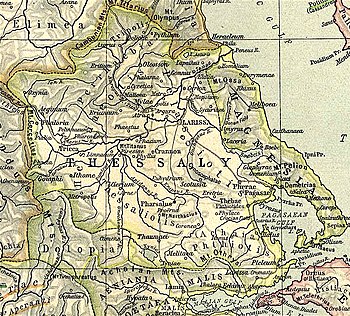Gyrton (Thessaly)
39°47′53″N 22°34′11″E / 39.798151°N 22.569853°E

Gyrton (
Others say that it derived its name from Gyrtone, who is called a daughter of Phlegyas.[9]The Gyrtonians are mentioned among the Thessalians who sent aid to the Athenians at the commencement of the Peloponnesian War.[10] The name of the city frequently occurs at a later period, by Livy, Polybius,[11] Pomponius Mela/[12] Pliny the Elder,[13] and Ptolemy.[14]
Gyrton also minted coins.[15]
The location of Gyrton is a site called Mourlari, southeast of the modern town of Evangelismos.[16][17]
Archaeology
The acropolis and the lower city were fortified, possibly already in the Archaic Period. The walls were built with slate.[18]
Gyrton minted silver and bronze coins in the
References
- ^ a b Homer. Iliad. Vol. 2.738.
- ISBN 0-19-814099-1.
- ^ Strabo. Geographica. Vol. ix. pp. 439, 441. Page numbers refer to those of Isaac Casaubon's edition.
- Ab urbe condita Libri[History of Rome]. Vol. 36.10, 42.54.
- Ab urbe condita Libri[History of Rome]. Vol. 42.54.
- ^ Apollonius of Rhodes. Argonautica. Vol. 1.57.
- ^ Strabo. Geographica. Vol. ix. p.442. Page numbers refer to those of Isaac Casaubon's edition.
- ^ Stephanus of Byzantium. Ethnica. Vol. sub voce Γυρτών.
- ^ A Dictionary of Greek and Roman biography and mythology, Gyrton
- ^ Thucydides. History of the Peloponnesian War. Vol. 2.22.
- ^ Polybius. The Histories. Vol. 18.5.
- ^ Pomponius Mela. De situ orbis. Vol. 2.3.
- ^ Pliny. Naturalis Historia. Vol. 4.9.16.
- ^ Ptolemy. The Geography. Vol. 3.13.43.
- ^
 Smith, William, ed. (1854–1857). "Gyrton". Dictionary of Greek and Roman Geography. London: John Murray.
Smith, William, ed. (1854–1857). "Gyrton". Dictionary of Greek and Roman Geography. London: John Murray.
- ISBN 978-0-691-03169-9.
- ^ Lund University. Digital Atlas of the Roman Empire.
- ^ Stählin, F. (1924). Das hellenische Thessalien, pp. 88-89.
- ^ Rogers, E. (1932). The Copper Coinage of Thessaly, pp. 227-237.
![]() This article incorporates text from a publication now in the public domain: Smith, William, ed. (1854–1857). "Gyrton". Dictionary of Greek and Roman Geography. London: John Murray.
This article incorporates text from a publication now in the public domain: Smith, William, ed. (1854–1857). "Gyrton". Dictionary of Greek and Roman Geography. London: John Murray.
